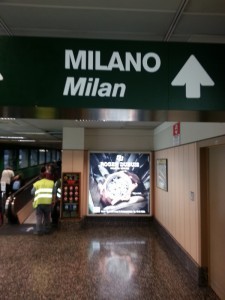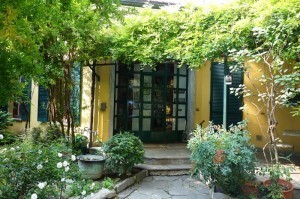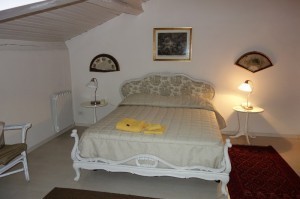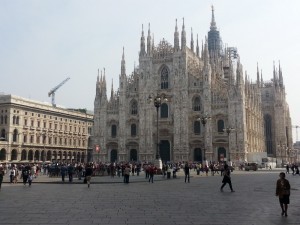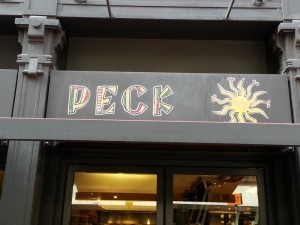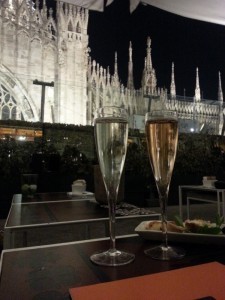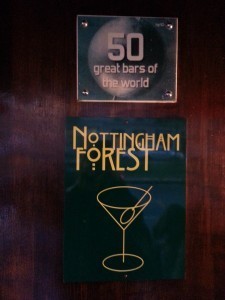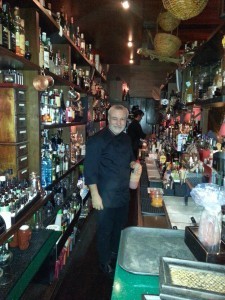Lisa Niver's Blog: We Said Go Travel, page 454
November 13, 2013
Morocco: Why does Abdul Live in the Desert?
 Anna puts her hand on my leg as I climb into the four-by-four. We’re in the small Moroccan town of Rissani, our final stop before Erg Chebb – one of Morocco’s Saharan ergs. Mustafa, the driver, smiles and says, “Welcome Maroc” – a phrase we’ve heard at least two dozen times in half a dozen towns. “Merci,” I reply.
Anna puts her hand on my leg as I climb into the four-by-four. We’re in the small Moroccan town of Rissani, our final stop before Erg Chebb – one of Morocco’s Saharan ergs. Mustafa, the driver, smiles and says, “Welcome Maroc” – a phrase we’ve heard at least two dozen times in half a dozen towns. “Merci,” I reply.
It’s nearing the end of September, but the heat emanates off the crassly paved streets and tumeric-yellow sand. Out the window, a young boy rides a motorcycle down the footpath past the men sleeping on trash out front of their stores. The female students are on their bicycles, dressed in white hijabs, heading home from the Quranic school. “In Rissani, students are very smart, but very poor,” Mustafa tells us. We drive through the gates of the town and into the desert, along dirt tracks carved by tires. The car comes around the berth of the great Saharan dunes, and in the distance we see our accommodation: a windowless stone building surrounded by eight-foot stone walls. Ten camels are dozing by the walls, although we are told by Mustafa, “the camel never sleeps”.
We unload our bags and head barefoot into the dunes. It takes half an hour to reach the top, and once there we both fall silent. A full moon hangs over the Moroccan-Algerian border – while to the West, we catch the diffused pink and red of the setting African sun. It seems surreal, impossible. Our silence is shortlived, as three Berber children follow us up the dunes and try to sell us handmade dolls, stones, and jewelery. I empty my hip pocket and show them I have no Dirham. They giggle and make me empty the rest. The youngest, a toothless girl in pink and white points and laughs, and they all run back down to find other customers. Once night falls, we head in for vegetable tagine and mint tea, and then to bed.
The next evening, our guides Muhammed and Abdul saddle up two camels for us, and we head into the desert. “Fatima, Ali Baba,” Abdul addresses us. “Tonight you will sleep under the stars.” Our camels sway and weave effortlessly through the soft Saharan sand. As the sun sets, the contoured shadows stretch further and further, until they flood the entire desert in cool grey. We arrive at the tent to the now familiar sight of stray cats searching for food. Anna gives them some of her water and we lay down on the magnificent Moroccan rugs set out prior to our arrival.
After dinner (more tagine, more tea) Abdul and Muhammed take us further into the dunes. The stars are hardly visible due to the fierce moon, which lights the entire desert as if it were a flood light. Muhammed sets some shrubs ablaze to ward off snakes and we sit down. “I have a joke,” Abdul tells us excitedly. “Why does Abdul live in the desert?” “Why?” I ask. “Because he is… Abdul!” They both laugh hysterically, and we follow along. To Abdul this is a gag, perhaps lost in translation… But to us, it seems strangely profound – Abdul lives in the desert because that’s the life he was born into. He never once questioned this; he was born a Berber, and so he will live and die a Berber. We continue exchanging jokes until we laugh ourselves tired. That night, Anna and I sleep hand-in-hand on the Saharan ground, looking to the starless sky. We dream of the whistle of sand over the endless dunes and of the moonlit birds flying overhead, searching for something to feed upon.
About the Author: Michael MacKenzie: I’m a twenty-one year old writer who quit his job, packed up his stuff, and went traveling around Europe, Africa, and Asia for half a year. I’m currently undertaking an Honours project focusing on the narrative linearity and serialisation of travel writing. Travel and writing are my two biggest passions. Earlier this year, I was shortlisted for the World Nomads’ travel writing scholarship to Beijing, which has made me more determined than ever to get my foot in the door of a career in travel writing.
The post Morocco: Why does Abdul Live in the Desert? appeared first on We Said Go Travel.
November 12, 2013
How I Tried to Fall in Love with Rome
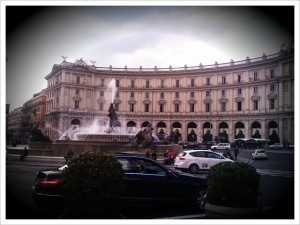 Rome – La Citta Eterna – has failed to make me fall in love with it. During our two-week vacation in March 2012, we have planned to spend several nights in Rome, allowing us enough time to at least scratch the surface and decide whether we love it or not.
Rome – La Citta Eterna – has failed to make me fall in love with it. During our two-week vacation in March 2012, we have planned to spend several nights in Rome, allowing us enough time to at least scratch the surface and decide whether we love it or not.
Rome met us with sunshine and made us dig up our Italian knowledge to get a map at Tributina Station. We have booked a place to stay close to Termini Station, having researched Rome hotels and booked a room ahead of time. So we decided to walk between the two train stations.
And by the way, I know that Termini area is not exactly one of the most recommend areas to stay in for first time travelers to Rome, but we wanted to be close to the airport transportation (our flight to Athens was early in the morning) and that departed from Termini. And we are not easily scared by “shady areas” anyway.
Plus, we looked at the map and saw that the Roman Forum (Foro Romano) and Coliseum (Colosseo) were within walking distance. After we checked in at the hotel and grabbed something to eat, we got the map of the city and started walking towards the Roman Forum, passing by a stunning old church we visited, S. Maria degli Angeli.
By chance alone we discovered that the church is housing Galileo’s Pendulum. For those of you who might just gave the screen a blank stare, a pendulum is basically a weight suspended from a pivot, so it can swing. When you move it away from the equilibrium position, due to gravity it would be forced back towards that equilibrium position. Galileo Galilei discovered the regular motion of pendulum which was used for time keeping.
Both of us being geeks, we spent quite a bit of time reading the information available, taking photos and exchanging whatever knowledge we still had about it from our school days.
Then we took a look at the map and followed the road leading to Foro Traiano (Trajan’s Forum), where we ended up right smack in a scam. One of the most well-known scams in Rome, to be exact. Please do not laugh. We were taking photos on the steps leading to Trajan’s Forum and a guy dressed in Roman solider approached us and offered to take photos with us; first with me, then with my boyfriend. Spotting something fishy, I was taking additional care of my purse fearing I’d get robed. Well, I did, but the guy was …more efficient than plain old robbery. He asked 10 euros for being in our photos. I was fuming and, seeing with the corner of my eye that a police guy just stopped nearby, I told the soldier “take 5 and go or I’ll tell that police guy”. The “soldier” than asked: “so where are you from?” The answer made him leave faster than my police line.
 It was a rookie mistake, reason for which I was fuming all the way to the Coliseum passing by the Roman Forum and all I wanted to do was to get a good night’s sleep as we had to wake up at 4 a.m. the next morning.
It was a rookie mistake, reason for which I was fuming all the way to the Coliseum passing by the Roman Forum and all I wanted to do was to get a good night’s sleep as we had to wake up at 4 a.m. the next morning.
But, we still decided to give Rome a chance during the two days we still had planned in the city after our return flight from Athens.
Whether it was visiting Athens and falling in love with it, the scam which still bugs me almost two years later, or just not being able to make friends with Rome despite spending hours in the Foro Romano on the full day we had in Rome, the city failed to make me fall in love. However, I was impressed and indeed, it is a “walk in museum”. It’s enough to just walk aimlessly in the city to see a lot of interesting monuments.
Maybe next time, Rome, you’d manage to make me fall for you.
All photos by Traveling Cricket and may not be used without my permission.
The post How I Tried to Fall in Love with Rome appeared first on We Said Go Travel.
Italy: Exploring Milan
Milan, in the north of Italy, is famous for its fashion. But, most people I know don’t see the point in visiting the city. I disagree. On almost every trip I take to Italy, I find myself spending a day, or two, in this large beautiful city where I do a little shopping, of course, but also some exploring.
Flying into Milan’s Malpensa airport, the Malpensa Express is a 29 minute train that costs only 11 Euro into the heart of Milan (Milano Cadorna station). Quick, easy and inexpensive, this is the best way to get to/from the airport.
The next challenge is finding accommodations. While there are many hotels in Milan, finding something central that doesn’t cost an arm and a leg, but still has charm, can be a challenge. Instead of a hotel, renting an apartment or villa for a few days makes you feel like a local. Check out NovecentoCase, an agency specialized in renting apartments in city center, who partners with 5 Star Service run by Alejandro Mazza and Emotionphy Communication. They focus on finding private luxury villas that sleep between 1-6 people and include hotel amenities such as toiletries, robes and a concierge.
Once settled in, the exploring begins……….
A trip to Milan is not complete without a visit to the Duomo, the Gothic cathedral that took nearly six centuries to complete. The
magnificent building sits in the center of Milan and is the fifth largest cathedral in the world and the largest in Italy.
Around the corner from the Duomo is Peck on Via Spadaria, an epicurean dream. Whether you want to pick up fresh pasta to cook for dinner or pick up some food to eat on the go, Peck is the place to visit. You can also load up on epicurean goods from the region such as olive oils, saffron and truffle salt at Peck. There is also a restaurant on the top floor, should you want to sit down and be served.
During the day, all of the top designers have stores around the Duomo. It’s fun, and a good workout, to walk up and down the streets, exploring Galleria Vittorio Emanuele II, the world’s oldest shopping mall, the designer showrooms on Via Spiga and everything in between. After all that walking and shopping, nothing is better than an afternoon gelato. Stop by Grom (with 7 locations in Milan, ask anyone on the street and they will point you to the nearest one). Grom makes artisanal gelatos, made with high standards and top quality raw materials. They use only seasonal fruit and no coloring or artificial additives.
As the sun sets, the best place for the afternoon aperitivi is on the roof of La Rinascente department store, across from the Duomo. Enjoy a glass of wine, which includes a few small plates of snacks, while looking at the lit up Duomo.
Another great spot for aperitivi or after dinner cocktails is at Nottingham Forest Bar (Viale Piave, 1 20129 Milano, Milan), considered one of the world’s best bars. Open at 6:30pm Tuesday – Saturday, it is a small bar and they don’t take reservations. But it is worth the wait outside as this teeny little bar is at the forefront of Milan mixology. Bartender Dario Comin specializes in molecular mixology and each cocktail is an artistic masterpiece.
Although Milan is the main industrial, commercial and financial center of Italy, it is definitely a city to be explored.
The post Italy: Exploring Milan appeared first on We Said Go Travel.
Kenya: Serengeti Surprise
Charles pulled out the biggest kitchen knife from his box of utensils and laid it out on the makeshift table beside him. It glinted in the early morning sunlight. This was all he had to protect himself.
A few hours earlier, this place had been crammed with trekkers: little groups huddled over fires, telling tall stories in a muddle of languages. Someone claimed they’d seen a lion stroll nonchalantly through the middle of the campsite and out the other side before disappearing into the darkness just a week or two ago.
That morning, we over-landers went off into the Serengeti in search of game, Charles stayed behind, alone in the camp. There was nothing between him, the bush and the lions…
Charles didn’t dwell on what was out there; he had a job to do. First, he built a coal fire. Whilst the coals burned, he prepared a mixture. Once the ingredients were blended to a rich, smooth and creamy consistency, he poured it into a battered crock. Seeing the coals were glowing white, Charles held his calloused hand over the fire. The heat was so intense he pulled his hand away sharply. “Good,” he thought to himself. “It’s time to set up the Dutch oven. “
Carefully, he laid four large flat stones on the metal ring, followed by a layer of coals. Next, he set the crock over the layer of stones and coal. Using tongs, he placed yet more coals around the croak and finally another layer on top. All he had to do now was wait.
As day drew to a close we returned to camp exhausted but exhilarated, our minds playing back a film of memories, a thousand images of the wildlife we’d seen roaming the vast canvas of the Serengeti. As the sky drained of light, and the world switched from muted colour to monochrome, Charles laid out a banquet:
First the chapattis; charred-crisp and finger-tingling hot, tasting deliciously smoky from the fire; Then githeri, a steaming stew of beans and potato; followed by ugali, a filling corn dish and kuku paka, a delicious spicy chicken and coconut dish.
We ate with our fingers, using the chapattis as spoons. As we sat in the darkness by the glow of the campfire, all the perfumed and spicy flavours of Africa, Arabia and India merged and hit our senses in sweet ecstasy. Somewhere in the distance we heard the cackle of hyena. Somewhere beyond the camp, we heard a roar. Our backs stiffened.
Then Charles unveiled his pièce de résistance: a chocolate cake. With a flourish he presented it to my birthday child of 11 who gazed at it in disbelief. A birthday cake? In the middle of the bush? Without electricity or an oven? Was that possible?
Charles, our magician chef, who whipped up fried eggs in seconds, and shouted ‘Doant waat’, had done it again. He had pulled the rabbit out of the hat – or a freshly baked chocolate cake from the camp fire.
About the Author: Helen Moat spent her childhood squished between siblings in her Dad’s Morris Minor, travelling the length and breadth of Ireland. She’s still wandering. Helen blogs at: http://moathouse-moathouseblogspotcom.blogspot.co.uk/
The post Kenya: Serengeti Surprise appeared first on We Said Go Travel.
November 11, 2013
Whangamata: The flood of memories
 I was always lucky as a child. My family were huge believers in travel and from the day I was born my father had already began mapping out a family trip. Being half Filipino it was to first visit my Mothers family back home. However, no matter how many countries we traveled too when I was a child it was always just one place that I demanded we go back to.
I was always lucky as a child. My family were huge believers in travel and from the day I was born my father had already began mapping out a family trip. Being half Filipino it was to first visit my Mothers family back home. However, no matter how many countries we traveled too when I was a child it was always just one place that I demanded we go back to.
Whangamata.
Situated in the Coromandel of New Zealand right in my backyard. Every year my family would spend two amazing weeks there. AS kids my companions were my cousins and my siblings. It was great. We’d run around the beach, build sand castles and eat ice blocks until our tongue turned another colour. I always waited and waited for the summer to roll around for us to go back.
And then my Dad decided it would be a good idea to head to Japan to live. And while I loved it I experienced some pretty terrible home sickness. Eventually my Father consented to sending me back home. To which I demanded to my Grandmother, with whom I now lived, that we again head to Whangamata. Which we did.
I frolicked as blissful and as happy as any 13 year old could be. And so every year we’d spend another year at Whangamata. This time learning to surf and exploring on my own a lot more. Then everything changed when I turned 15. Being a teenager and full of hormones, I of course was busy perving at all the cute guys along the beach. And then I met Martin. The girls and I were being typical giggly teenage girls and wolf whistling (such ladies right?) at the boys going past. Martin and his friend whistled back and that was the beginning of our history. Turns out we had much in common including our birthdays. We were born only 30 minutes apart. It was almost as though fate intervened. I guess at 15 you can never under estimate the feelings of love and for me it was pretty strong. Sadly summer came and went. And our little romance had to come to a close. However it was not all a sad story, after 10 years Martin and I remained amazing friends and still continue to reminisce about our summer together.
Whangamata held so much more for me than I ever anticipated as a child though. In 2011 now a 23 year old woman, I experienced a heart break like no other. And so in a desperate attempt for an escape I rallied my girlfriends and headed away to my treasured spot. Where time healed like no other. I once again giggled, swam, and frolicked under the stunning Coromandel sun and realized that memories of a place, no matter how much it changes always stay with you and there is nothing like creating new ones in your own piece of heaven.
About the Author: Mei-ling Kirkpatrick: New Zealander who is crazy about travel and writing as much as I can about my experiences. Here and abroad.
The post Whangamata: The flood of memories appeared first on We Said Go Travel.
Auroville, An Experimental Town in India
Imagine an experimental town in South India called Auroville where the earth is a rich red. Where the people–from all over–live off only the foods and products they produce in their organic farms. A tranquil place surrounded by trees, wildlife and Tamil villages, and guesthouses each with it’s own futuristic edge. And in the center of it all sits the Matramandir, a gigantic golden ball like something you’d see on The Twilight Zone. Only, it was built by people of the community, the Aurovillians, years ago to signify the town’s primary goal: human unity and finding one’s consciousness–a vision of “The Mother.”
Call it hippie town, call it retirement, call it a haven in a small part of Tamil Nadu, India–but it does exist. Russ and I went to visit Auroville during out six-month stay in India. We stayed only four days in Creativity: a cozy four-room guesthouse with a small community kitchen. The cost was 590 rupees a night with breakfast. It was quiet there and butterflies fluttered around the garden. All sorts of colors and sizes. We would see them each time we left the complex, mostly to walk up the road to the Solar Kitchen.
The Solar Kitchen is a huge dining hall where Aurovillians eat lunch and dinner at scheduled times. As a visitor, you’ll get an Aurocard. It’s like currency, you can’t do much in Auroville without it. Inside the kitchen, the receptionist swipes your card–lunch is 100 rupees for visitors, dinner is 80–and you’ll pick up a silver tray. Prepare to get mountains of Tamil food: idli, samba, dosa, chapatti, coconut chutney, the works. But don’t take more than you can eat, a sign hanging above will tell you that. There’s no wasting in Auroville, and uneaten food goes back into the soil, you’ll notice the special recycle bins.
There’s even a quiet section for those who choose to practice mindful eating. My husband and I made the mistake of sitting there our first day. A long man with a long face and long gray hair came over and pointed to the “no talking” sign at the edge of our table.
“I like to think of this area as my personal refuge.” He told us.
Only once did we visit Auroville’s main attraction, the Matramandir. First timers have to schedule a visit and go through a long orientation. Inside the Matramandir, you’ll hear the whirling wind as clear as ever. But you won’t feel a breeze. You’ll step on smooth white merino wool carpet wearing white socks handed to you at the door.
Inside the inner chamber, floor cushions surround a crystal globe. A beam of natural light projects from a mirror in the ceiling, striking a ray of sunlight onto the crystal and illuminating the entire insides of the dim meditation room. You won’t hear a thing in there. And even though you’ll try, it’s like the padded walls in that room somehow found a way to capture usual silence.
The Matramandir was the best part!
The post Auroville, An Experimental Town in India appeared first on We Said Go Travel.
France: Awe and Tears at the Zoo
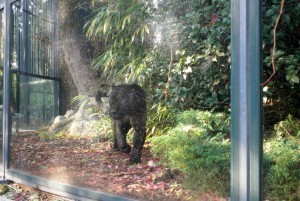 A zoo in winter is a strange place to feel awe. A zoo is a place that symbolizes captivity, leashed freedom. But it’s not the place, although the Menagerie of Paris, France is one of the better zoos I’ve seen. With wide, clean paddocks, there is enough space, but not here. Not for this animal, and he is why I feel awe. And sorrow.
A zoo in winter is a strange place to feel awe. A zoo is a place that symbolizes captivity, leashed freedom. But it’s not the place, although the Menagerie of Paris, France is one of the better zoos I’ve seen. With wide, clean paddocks, there is enough space, but not here. Not for this animal, and he is why I feel awe. And sorrow.
The Northern Chinese Panther is pacing in front of me, tension in the sleek muscles bunching beneath the smooth yellow and black pelt. His light amber eyes bounce around, seeming to pin all of us who just stand there and look with a promise of retaliation. His strong jaw opens, showing the thick yellowed fangs. A warning to the children on their school trip, who jump, scream and keep pace with him. Not that they understand the warning. To them, he is a pretty kitty in a glass cage.The panther is separated from the gawking crowd by a railing and a thick sheet of glass. Above the glass are metal bars, allowing sound and air to enter the cage.
I raise my camera, jockeying with the mothers and fathers around me to try and get a picture of the fast pacing cat, but I soon give up and switch to video. No matter my empathy for him, I still act like a tourist, watching him pace, taking pictures, and moving on.
Next to the panther, a black jaguar paces just as restlessly. The bumps of his spine undulate as he moves back and forth, blinking rapidly and refusing to look at anyone. He is so close I can see the darker rosettes in his slightly lighter colored fur. His large, heavy head swings back and forth, and I can imagine him searching for somewhere to run and hide. His jaw opens and closes, almost as if he is meowing like a house cat, but there’s no sound. The wind grows colder, the laughter and calling, as well as the clicking of cameras, seems to be louder. I can see the cat’s ears twitching, taking in the rush of noise. Again, I take my video and move on.
I step around the teacher counting his kindergartners and come to the last cage, where a clouded leopard sits right in front of the glass, as if daring the world. His light grey fur is shaggy and long, the dark rosettes often blurring into the grey. The fur of his tail is puffed up, making it look twice as big as the other big cats’. His head is arrogantly turned away, but every now and then he will turn and look disdainfully at someone who is waving at him, trying to attract his attention. He appears outwardly calm, almost defiant, but his ears are tellingly laid back. He is smaller than the panther and jaguar, but stockier, more than likely able to hold his own in the wild. So why aren’t they there?
I take a few pictures and move on, listening as the birdsong gets louder and more frequent the further I go from the cages. The rest of the zoo seems to be mostly herbivores, and I practically ignore them as I think about the cats. I might be a hypocrite, but whereas I can look at the grazers and smile and think they’re cute, I can’t imagine the cats are happy in their glass pens. To me, there’s something fundamentally wrong with keeping a predator locked up. Such a strong, beautiful animal should be free to roam the wilds. And whenever I see them, I’m always inspired to be more. To become a vet, a wildlife conservationist, or a zoologist. To do something amazing with my life, that will help these cats to flourish.
I circle back around to the cats, and walk up to the panther. He’s now sitting up on a rock, so that the wind can touch him through the bars. Our eyes meet and for a few seconds I think I can see the sadness in his eyes. And tears well up in mine.
About the Author: Simone Gambrell is a 24 year old South African, currently living and working in Paris, France. She has a Bachelor of Arts degree in Languages and Ancient Cultures, as well as a certificate in travel writing from MatadorU. She enjoys travelling and writing, but hasn’t yet published anything and keeps forgetting to set up a personal blog.
The post France: Awe and Tears at the Zoo appeared first on We Said Go Travel.
November 10, 2013
Music on the Road: The Five String Addict
Today is George’s birthday! I wanted to share one of his latest articles about music: “The Five String Addict’: A Guitarist’s Review of Keith Richards’ Life Memoir” HAPPY BIRTHDAY to my soul mate, travel partner and a great writer and musician. Enjoy his new article and book review!
In Keith Richards’ memoir, Life, the Rolling Stone guitarist rocks readers along his lifelong journey that began on December 18, 1943. Life chronicles Richards’s career with the Rolling Stones since 1962 and tracks them from small clubs to massive arena concerts. Expected are the Rolling Stone drug induced antics, sexual escapades, and belligerent disregard toward authority. According to Richards, “If you’re going to kick authority in the teeth, you might as well use two feet.”
Unexpected is Keith’s ability to recall detailed minutiae such as the precise amount of money the Stones were paid for their very first gig in London; it turns out that Keith maintained a thorough diary. The Stones guitarist is articulate and well narrated with the assistance of James Fox. Particularly enjoyable was the description of how he came up with possibly the most iconic tune of all time, “Satisfaction,” literally while he slept!
Keith Richards’ contribution and historical importance as a guitarist and songwriter cannot be overestimated. Life details Keith’s love of music, his guitar playing style and chord construction techniques. More specifically Life delves into how Keith attains his unique signature sound and more importantly describes how his desire to imitate banjos from the old American south led him to remove the low “E” string and tune his guitar to an open “G.”
As a guitarist, retuning the instrument creates a discovery world since structured chords and scales are no longer applicable. This tuning was used to create archetypal Stones classics. Keith stated, “With the five-string it was just like turning a page; there’s another story. And I’m still exploring. With five strings you can be sparse; that’s your frame, that’s what you work on. ‘Start Me Up,’ ‘Can’t You Hear Me Knocking,’ ‘Honky Tonk Women,’ all leave gaps between the chords.”
CLICK HERE TO READ THE FULL ARTICLE
About the Author: George Rajna, M.B.A., Masters of Science in Communications Disorders, is a bilingual speech therapist who has traveled to over one hundred countries across six continents. He composes music on the guitar and ukulele, and spent two years working in rural education for Peace Corps Paraguay. He is the co-author of Traveling in Sin. Since July 2012, George and Lisa have been living abroad in Southeast Asia follow their journey at We Said Go Travel.
The post Music on the Road: The Five String Addict appeared first on We Said Go Travel.
As the World (and Washing Machine) Turns
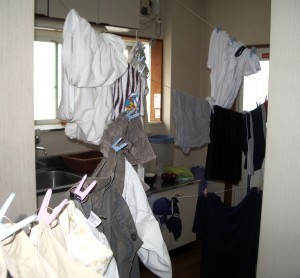 Fall is my favourite season. The smell of the cool fall air is clean and fresh, and I love the crunch of leaves as I crush them against the sidewalk under my shoes.
Fall is my favourite season. The smell of the cool fall air is clean and fresh, and I love the crunch of leaves as I crush them against the sidewalk under my shoes.
Fall may be my favourite season, but what’s really amazing is that seasons exist. No matter where you go, they’re are unavoidable. As humans we fight against them, adapt to them, and ultimately survive them. During my travels I’ve learned to adapt to survive. When it comes to doing one of the most mundane and necessary chores ever, my adaptation has been especially difficult: laundry. Adapting my laundry to different seasons has not always been dignified, but always worth it.
Japan
One season I experienced for the first time in Japan is the rainy season. It’s not the type that brings deluge 24/7, but does get pretty dreary. I was amazed at how the weather could be so consistent for so long, and also at an unexpected downside: the difficulty with laundry.
The apartment my husband and I lived in consisted of a kitchen, a bathroom, and one bedroom. There wasn’t much room for the washing machine, let alone a dryer. The balcony barely had enough room to stand in front of the washer to hang wet clothes on the clothesline.
Hanging our laundry outside to dry had been hugely successful in the summer. When the rainy season came, it would be wetter after hanging on the line that when it had come out of the washer. We decided to solve our problem by hanging our laundry inside.
Using our ingenuity, we rigged up multiple clotheslines inside the apartment. String was tied up close to the ceiling and strung across the room, attached to anything that wouldn’t fall over. Loading it up with laundry, we had solved one problem but created another: we now lived in a damp and smelly laundry-maze.
After two months, rainy season ended and our clothes returned to the outdoor clothesline. Our tiny space was liberated at last! …Until next year.
The rain made it difficult to dry our laundry, but when I looked out at the trees, enjoyed Japanese gardens, or caught a glimpse of the sunrise through the peaks of a misty mountain, I knew that without the rain I wouldn’t be enjoying the beautiful green scenery. A damp, crowded apartment was a small price to pay for such an amazingly lush setting.
Guatemala
The summer season in Canada is unbelievably short and cool compared to a tropical country. It’s wonderful to leave winter’s chill behind and escape to a place where summer is hot. Unfortunately this kind of escape doesn’t allow your body time to adapt to the heat.
When my husband and I travelled to Guatemala, we decided we would rather be hot and uncomfortable than in unbelievable sunburn-pain. We wore long pants and long sleeved shirts.
We didn’t get sunburned, but we did leave a swath of stench behind us. Or more precisely, a ball of stench in our backpacks.
Ziplock bags came in handy for sealing away our nasties and separating them from our (relatively) fresh clothing. However, like all carry-on luggage travellers, there came a time when we ran out of clothes: it was laundry time.
Our guesthouse offered laundry service, and we needed it badly. As we emptied our stench sacks out of our backpacks to consolidate into one laundry bomb, I considered how embarrassing it was to have such filthy clothing. Some of our clothes were so wet it was like we had gone swimming in them…but we hadn’t.
As we handed over our pile of laundry to the man at the desk downstairs, I watched his face for a reaction to the giant, gross mess we had just given him. Before he said anything, we both turned and fled up the stairs back to the room. We consoled ourselves with the thought that they probably get similarly awful laundry from other guesthouse visitors.
When we got our laundry back the next day, it was clean, and folded, and wonderful.
The heat made it unbelievably embarrassing to hand over our laundry at the guesthouse, but not needing a sweater at night, enjoying tropical fruit for breakfast, and relaxing on the beach were more than worthy trade-offs for my pride.
No matter where you live, seasons are a part of your life just like laundry. I’m grateful that seasons exist, and that humans are so good at adapting. Myself included.
About the Author: Heather Sinclair loves traveling, cooking, and scuba diving. She currently works as an engineer and writes when she can find spare time between playing soccer, doing yoga, judging poetry slams, and P90X.
The post As the World (and Washing Machine) Turns appeared first on We Said Go Travel.
November 9, 2013
Employee Speak: eBay’s Outsourcing Operations in India
Employee Speak: eBay’s Outsourcing Operations in India
Most Americans were understandably outraged when they lost their jobs to Indians in the early 2000s due to the infamous Business Process Outsourcing culture (BPO). Meanwhile, urban Indians just out of college took home huge pay checks their parents never saw in all their working life. The price however, was to be paid with horribly skewed body clocks due to graveyard shifts, and an abnormal dependence on caffeine and nicotine to stay functional. It was not uncommon for workers in their 20s to suffer cardiac arrests and even succumb to them. The agents (as they are called) were sometimes racially abused by Americans, Brits and Australians who immediately saw through the fake Western accent or incorrect grammar and syntax. The bubble burst in 2008 and gradually agents were laid off in India too.
What about the American guy who worked with an American company that outsourced operations to India? Tyson Perna, former eBay employee who worked out of Salt Lake City, Utah, recounts his experiences.

Tyson Perna
My 1st trip to India
I first went to India in 2007, 5 years after I started working for eBay. I was a supervisor in the billing department, and when billing chat was outsourced to India, I moved over to the Outsourcing department to be a liaison between them and the billing teams in India. The hope was, I think, that I would bring my billing knowledge to the Outsourcing department to help better manage the teams in India. The first trip, to Mumbai in Dec of 2007, had no real goal. We had money left in the travel budget for the year, and we had to use it up. But I focused on our low satisfaction scores and was able to help improve them. I went to Ahmedabad in April 2008 to help train when we opened a new centre there at Motif.
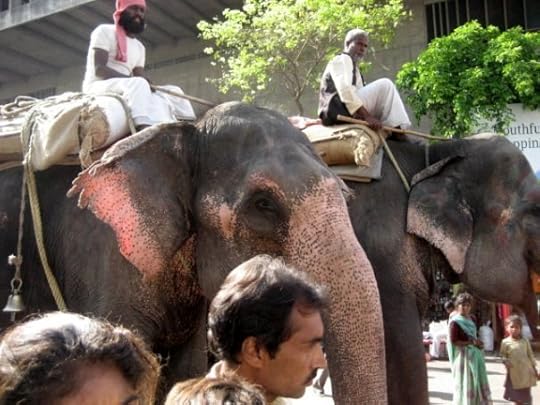
Of course, there were elephants
Did my perception of India change after coming here?
I had envisioned India as a mix of old and new before my trip. That didn’t change. The past and present seem to live side by side in that country in a way we don’t understand in the US, with our 400 short years of history. I had no preconceived notion, though, of how Indian’s viewed themselves and their country. That’s what I learned. I was a little disappointed to learn that so many Indians seemed to measure progress by how closely they were following in the paths of the western countries like the US, UK, and Germany. I didn’t hear or see any indication of India forging a new path, its own path. I was disappointed that they seemed content to follow. I thought that with the potential of so many people and such a large country, they, along with Brazil and other emerging countries, could be taking advantage of the opportunity to learn from our mistakes. I saw no sign of any attempt to do so. Similarly, the young people I encountered seem to measure their own modernity and freedom by how much of Western culture they adopted.
My impressions on the work culture at IBM Daksh (eBay’s outsourcing partner in Mumbai)
I found the work ethic and quality of work to be identical to that found at our site in the US in almost all ways. There were some additional hurdles, such as the remoteness and language barriers, but otherwise all things were very much the same. One difference I found was that the employees had to be pushed, prodded, and encouraged to “think outside the box.” They seemed much more comfortable in following established procedures rather than developing their own methods, where quite the opposite is true in the US. I often noticed that the ones who did learn to think creatively were the ones who seemed to advance.

Travel Through Rajasthan
T raining Indians in Various Procedures
IBM Daksh in Mumbai was much more western in nature than the centre in Ahmedabad (Motif). It was very familiar in a lot of ways. People looked bored while I explained billing. They would have been checking their cell phones if cell phones had been allowed on the floor. They liked to argue with me, or present different scenarios trying to stump me. It was much the same as training in the US.
The Difference between Ahmedabad and Mumbai
Our other centre, Motif in Ahmedabad was very different. Perhaps that’s the difference between Ahmedabad and Mumbai. I didn’t feel that the employees at Motif were encouraged to think for themselves or to learn how to problem-solve. It was all learning by rote. They wanted to be told a policy or procedure so that they could follow it exactly in every case. The trainers were quite strict. They spoke to the employees and subordinates in a way that is not common in the US.
Impressions on MINDSPACE, the outsourcing hub in Mumbai with its glass façade buildings
Is that what that area was called?  I looked like it could be any corner of a city in the US. As such, I expected to find such things in India, and didn’t remark on it too much. I do seem to remember more smokers than are common in the US. I don’t associate it with coolness though. I can’t stand cigarettes.
I looked like it could be any corner of a city in the US. As such, I expected to find such things in India, and didn’t remark on it too much. I do seem to remember more smokers than are common in the US. I don’t associate it with coolness though. I can’t stand cigarettes.
Working night shifts while training?
I did not work a night shift in Mumbai. When we were in Ahmedabad, some of the trainers I was there with from eBay did work the night shift for their entire month. Luckily I didn’t need to. But it was common to schedule meetings at odd times so that people from both the US and India could be on the phone at the same time.

Temple in Ahmedabad
Travelling through India
Mumbai seemed much more the metropolitan world city than Ahmedabad, but Ahmedabad seemed to be more “Indian” than Mumbai, which was more western. I didn’t get to get out much in the 12 days I was in Mumbai my first trip since I was there alone. But in Ahmedabad, I spent a month with several eBay co-workers, and we were able to go out and see the city and travel to a few local places, such as Jaipur. The diversity amazes me. The history was spellbinding. I feel like I could spend a life getting to know any one city. But the poverty depressed me too much to want to stay around for long. I wouldn’t want to be immune to some of those sights.
My thoughts on outsourcing and my job at eBay
I always had to defend my job in the Outsourcing Department, since outsourcing was never a popular topic. eBay’s former CEO, Meg Whitman, ran for governor of California and was defeated in large part to her role in outsourcing jobs from eBay. My thoughts on outsourcing in general are mixed. eBay did a good job when it outsourced, because it never laid off any internal employees. In fact, outsourcing allowed the company to move people from lower level jobs like answering basic emails and chats, to higher level, such as account management. But perhaps it would have been possible to do both.
Many of us felt Meg Whitman pandered to the stock analysts. The stock value was her only concern, and the stock analysts cared about margins. So she did what she had to do to improve the margins. I’m glad Obama found ways to incentivize companies to return work to the US. I wish he got more credit for doing so in the US. We have a notoriously short memory.
Quitting eBay
I left eBay in Oct of 2008 (5 years ago as of this past Tuesday) when I was laid off. We had a new CEO that year, and the layoffs were expected. Once the economy crashed in late 2008, the layoffs became inevitable. I believe around 1000 employees were laid off around the time I was. The new CEO has turned eBay into a typical company.
Everything about it that made it special is gone.
————————————————————–
Thanks Tyson Perna for this honest recount.
The post Employee Speak: eBay’s Outsourcing Operations in India appeared first on We Said Go Travel.
We Said Go Travel
We Said Go Travel is a global community of over sixteen hundred writers with articles from every continent.
Stories are shared with photos and video from a perspective of the transformative power of travel. We Said Go Travel has hosted live and online events as well as travel writing contests around the world. ...more
- Lisa Niver's profile
- 57 followers


